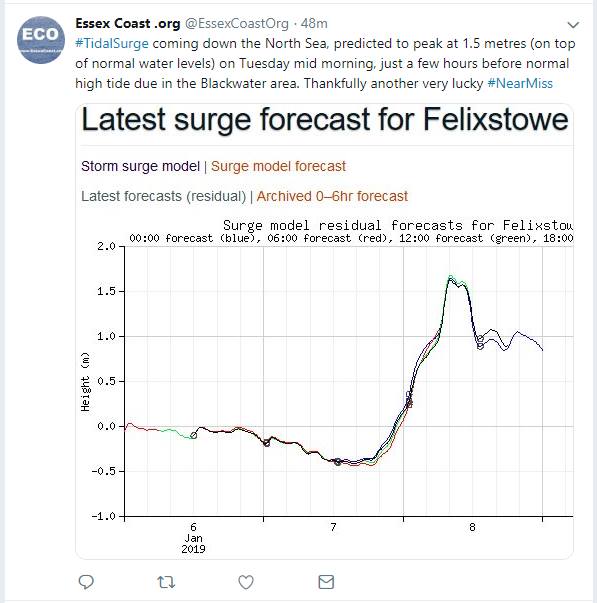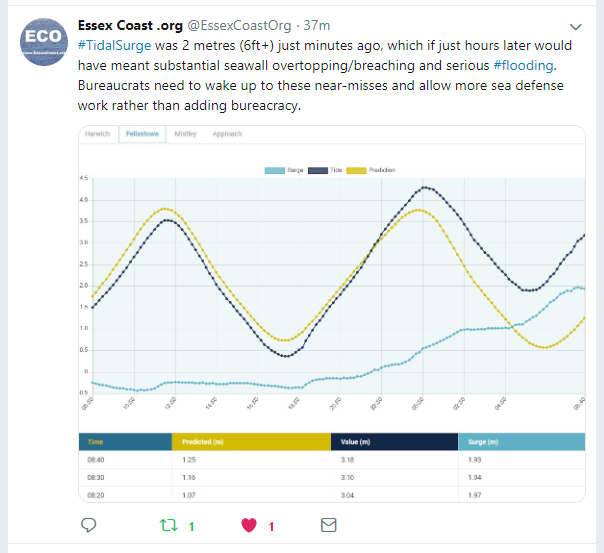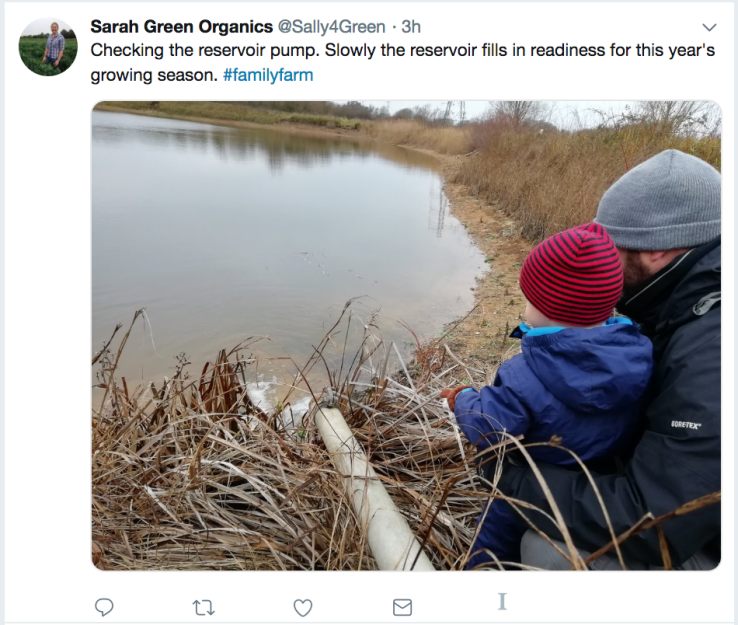
It’s now ten days since I wrote to my District Councillors (Peter Elliott and Ron Pratt) asking why Maldon District Council has no current Environment and Climate Change Strategy despite the Climate Emergency and I’m still waiting for a reply. I recognise that they may be busy, that it’s not a salaried role and their time may be stretched, so I think I’ll give them a month before I follow up with another letter seeking an update on progress. I’m also thinking about other ways I can raise this issue – ask the leader of the opposition on the council to raise it?, seek recognition at the town council level? Again, learning how local politics works is proving to be a case of just try stuff.
The urgency of the emergency was brought home last week with a tidal surge in the North Sea threatening the east coast. Thankfully it didn’t quite coincide with high tide when it would have mounted a significant challenge to flood defences. Regional flood defences were developed after the 1953 disaster in order to protect against these tidal surges, but sea level rise and climate disruption is adding new factors to consider. A new report in Science this week found that the warming of the oceans was accelerating and the resulting ‘thermal expansion’ is likely to raise sea levels by about 30cm by the end of the century (on top of the rise in sea levels from melting ice and glaciers). These warmer oceans are also a major factor in increasing the severity of storms, hurricanes and extreme rainfall.


In November last year the environment secretary, Michael Gove, gave a speech to Department for Environment, Food and Rural Affairs (Defra) stakeholders in which he said that flooding was one of the key ways in which climate change would become manifest in the UK adding:
‘It will not always be possible to prevent every flood. We cannot build defences to protect every single building or reinforce every retreating coastline. We will be looking at ways we can encourage every local area to strive for greater overall resilience that takes into account all the different levers from land-use planning to better water storage upstream, and tackles both flood prevention and response.’
Gove’s statement that we ‘cannot build defences to protect every single building or reinforce every retreating coastline’ was reinforced by the Met Office’s UK Climate Projections report, which warned that ‘[s]ome coastal towns may have to be abandoned because the huge cost of sea defences will make them “unviable”. Many stretches of prime, low-lying farmland could also be lost, with the lowest, such as Romney Marsh in Kent, the Somerset Levels and parts of Essex facing near-permanent inundation.’
So where is this local area of Essex’s planning for greater overall resilience to climate change? The need for an Environment and Climate Change Strategy has never been clearer, but Maldon District Council seems clueless or wilfully careless. One of our independent town councillors, Vanessa Bell, did refer to the tidal surge and the potential future impacts of flooding when the council discussed a riverside planning application this week. Once again, the local, independent politicians have demonstrated a duty of care that I hope will be shared by the tranche of Conservative incumbents.
Another reason I suggested that this District might be particularly concerned about addressing the issue of climate change in my recent correspondence was the risk of drought in this primarily agricultural area. We begin from a dry base here, the Met Office reports that much of eastern England receives less than 700 mm of rainfall per year and includes some of the driest areas in the country. The driest part of the UK is generally reported to be St Osyth (17 miles from here in BoC), which has been named as the driest place in the country for the past 40 years with an average annual rainfall of only 506.9mm.

The latest vegbox delivery from Sarah Green’s Organics bring Sarah’s account of the year’s rainfall on their farm in Tillingham (6 miles from here and in Maldon District):
‘I have totalled last year’s rainfall and compared it with previous years and it makes interesting reading. In 2018 I measured a total of 532mm of rainfall here at Mark Farm, surprisingly this is within our average annual rainfall amount. Dad, who has ben measuring rainfall for decades, states that our annual average here is 525mm. The very wet spring compensated for the very dry summer. Surprisingly I measured more rainfall in 2018 than in 2017, 507mm.’
That 2017 measurement is worryingly close to the average figure for the driest place in the UK and the 2018 record of erratic conditions is somewhat indicative of a pattern associated with global weirding. The total 2018 rainfall is higher than their average figure though, if not by much. Tracing any trend obviously needs a longer set of data, but continuing dry summers could cause problems if water isn’t captured and stored when it does rain. According to the Met Office climate projections the ‘chance of seeing a summer as hot as 2018 was less than 5% in the 1990s, but already that risk is between 10% and 20%, and by mid-century will be 50%’. Green’s have an on-farm reservoir, so they can mitigate some of this seasonal fluctuation – but where’s the district-wide strategy?

Down on Arcadia Road allotments the dry summer hit plot-holders, a rumoured turning off of the on-site taps never happened but maintaining sufficient irrigation still proved difficult leading to a depleted Allotment Show in August. Reports at the show on the 2018 growing season included: ‘such a hard year down on the allotment’ and ‘one of the most difficult and challenging years for growing vegetables I can remember’. Yesterday our plot neighbour told Claire that last year had been the driest he could remember in the 40 years he’d been coming to the Allotments. In early August plot holders were gently reminded that: ‘the use of hosepipes to directly water plots is not allowed, see condition of tenancy 8 on your membership card. You may use hoses to fill your storage tanks ONLY. In spite of the current weather conditions some plot holders persist in this activity’. In October the plot rates went up, with the Plot Secretary noting that ‘[t]he increase in water usage and the increase in the water costs have been a driver for this action’ and during the summer on-site bonfires, barbecues and other forms of burning were banned after an un-attended blaze got out of control and the fire brigade had to be called.
It wasn’t all negative news, in October a local beekeeper reported that ‘This year’s splendid summer has helped the UK’s beekeepers to report the highest yields for four years according to the National honey survey results published yesterday’. Sadly this was qualified however in his following sentence: ‘However this is no cause for complacency as a honey crop of 30 lbs per colony would have been considered small compared to yields a few decades ago’. He didn’t attribute a cause for this decline, but made the case for planting more appropriate nectar rich plants. Bees are certainly being affected by more than declining plant diversity though and it’s not difficult to imagine that the local field monocultures are also dosed in pesticides. Something of Essex’s chemical agriculture can be witnessed in the watercourses the fields run off into and the Essex Rivers Hub reports that upstream of here the River Crouch is affected by ‘diffuse agricultural pollution entering the river’ which ‘is described as ‘chronic”. There’s little reason to assume that the fields draining into the tidal Crouch produce any less pollution.
A resilient and healthy future for the region depends on the implementation and maintenance of ecologically appropriate mitigation and adaptation plans. Those plans must be informed and responsive to a changing climate – and change is here. I don’t care if Maldon District Council call these plans an Environment and Climate Strategy, as they have done in the past, but I do care about whether they address the issues of climate change and environmental degradation.

Reblogged this on and commented:
You would like to think that the local councils who presume to run our lives are capable of thinking about and planning for the long term, particularly when it comes to the impact of climate change. The frightening thing is that they don’t seem to see it as a priority. Which is why we need blogs like Dengie Bioregion who detail the threats climate change pose to the region and explain why action needs to be taken now…
LikeLike